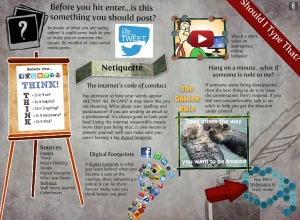H5 – Honor student potential for roles in the greater society. This standard states that teacher candidates are preparing students to be responsible citizens for an environmentally sustainable, globally interconnected, and diverse society, meaning students should be prepared to enter the real world with enough tools to help them make informed and knowledgeable decisions. With our world growing rapidly, it is also important for students to be educated in the changing environment and technology in order to be safe and responsible. Figure 1 shows a digital poster (or glog) I created as a potential resource for a 4th or 5th grade class. This glog discusses digital etiquette, digital footprints, thinking before you hit “enter” in any kind of social media or web sharing, and internet safety. It also provides additional content for students to view and explore either on their own or with parents, including links to more information, games to practice being digital citizens, and a video. Many school districts are finding positive results of direct instruction of digital citizenship to both teachers and students. For example, in Osseo, Minnesota, the school district is teaching digital citizenship to primary students as well as secondary students and teachers. Their program is aligned with ISTE’s National Educational Technology Standards, and provides a professional development program that “equips teachers to combine collaboration, creativity, and communication to create transformative content” (Ribble and Miller, 2013). Having created this digital poster, I realize that as a teacher it is my responsibility to not only explain how to be a digital citizen, but to model being one myself. That being said, I cited sources and followed my own instructions on the poster for digital etiquette. This poster is a resource for helping students learn how to become digital citizens, preparing them for their later roles in society. In creating digital (or other) resources, it is important that I spend time thinking about how I could present it, and whether it will be useful to a classroom or not. I also learned that it’s more time-consuming than I thought to create digital media for classroom use, though once this is created it is something I could tweak and edit, and reuse. However, it is a worthwhile use of my time, as I believe students can really benefit both from reading explicitly what digital etiquette is, then having the opportunity to both see a short video and practice what they’ve learned through a game. What may be more useful than a simulated game is actual real-world practice, where students can write social media posts to each other in a safe environment, and hold discussions from other members of their community, or even the world. This can be achieved through digital communication, using Twitter or blogs in the classroom, or by using Skype. All three are viable methods for student practice.
Ribble, M., Miller, T. (2013). Educational leadership in an online world: Connecting students to technology responsibly, safely, and ethically. Journal of Asynchronous Learning Networks, (17)1, pp 137-145.
